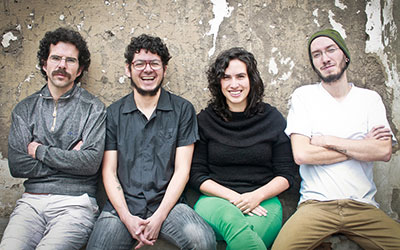Project description by Al Borde
Over here, people live without electricity, without sewage or running water. People do not use money; they have no jobs or professions. People do not measure time with clocks; do not use meters or rulers. Here there is no private property, nor institutions. Over here life is simple: if they are tired, they sleep, if they are bored, they play. They have ignored boundaries, morals and shoes. They do not need gods, laws, or degrees. They satisfy their needs almost obviously: the sea and the land are the supermarket and forest trees are the material to build their houses.
This community seeks progress. But for them, progress is achieved through personal enrichment. This enrichment has nothing to do with money, but with entertainment, technology, playing and sharing. We decided to be part of the project, understanding that the way to solve problems is directly, without intermediaries. It's not about making money to buy things in order to satisfy hunger. It is about understanding life, meeting one’s needs with the resources one possesses: the mind and the body.
The resources we had were the ones that defined the project: Irregularly shaped materials. Fishing and farming tools. Strong and skilled laborers who do not understand accuracy in terms of centimeters. The support of city volunteers who understand centimeters but have no labor experience. And a specific area with fuzzy boundaries. It was clear that the project would dispense with topography plans, would not need AutoCAD or Neufert.
Money is only another resource, as are human and natural resources. A simple system of minimal complexity is capable of adapting to the unpredictable variables of the land, labor and materials. The system allows for the discussion of the design and decisions at the time of construction.
Each person had a preferred task in the construction and involuntarily became good at it. Then began a process of perfecting the techniques; this led to specialists in each activity, optimizing processes. Finally the transfer of knowledge to another person is what ended up enriching the team. The possibilities of the system allowed the building to stop growing when the team deemed necessary.
The construction time was one week. The goal was to build a logical process of collective construction and understand the scope of the system. Once the community understood the process, we were no longer needed.
People occupied the place immediately. Habitable boundaries are fuzzy: The storage is suspended. A child runs off in a corner and transforms it. The interior and exterior are undefined. They detect if any of the spaces need modifications.
We said goodbye and when we returned, the community had embraced the system. A new stage had been built; spaces were modified with hardwood floors and bamboo walls. The pottery pieces that people found around the beach hung from ledges adapted to the sloping walls, like a museum that remembers past cultures.
In "Nueva Esperanza" school children learn to rely on the group, to fly towards abstract knowledge, to other worlds. But then comes a time to fly alone, landing in the concrete and the tangible. The group has helped them advance to a point where what they need are single launch platforms. Platforms that allow each one of them to take off towards a personal interest such as music, woodworking or aircraft. Like Pipo, a schoolboy who is passionate about airplanes, has studied how they work, and now build his own models. When these children take off they will become self supported space ships.
Text.- AL BORDE.











































